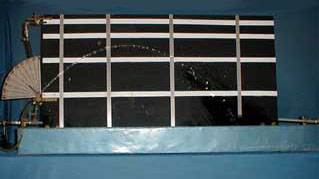Demos: 1D-22 Water Jets & Projectile Motion

Two water jets, one near the bottom of the board and one near the top are mounted so that the lower one can be pivoted to provide projection angles from zero to ninety degrees. The upper, fixed, one illustrates the range as a function of horizontal velocity, whereas the lower illustrates the range as a function of angle.
Directions: To illustrate demonstrate range as a function of horizontal velocity, turn on the upper spigot and steadily increase the water velocity. Have students focus on the horizontal white line that is even with the lower spigot. Refer back to the drop-kick demo to point out that the time of flight is the same for a chunk of the water, regardless of the horizontal velocity.
To demonstrate range as a function of angle, turn on the lower spigot and slowly move the spigot through an increasing angle. Make sure the students are focusing on the horizontal white line even with the spigot. At about 45° the range should be maximum. Show that two different angles can give the same range (angles symmetric about 45°).
Suggestions for Presentation: When using the lower spigot, draw upon the results of the upper one, namely that the horizontal range depends of the horizontal velocity. But time of flight also plays an important role. A larger angle means a longer time of flight, but less horizontal velocity. A smaller angle means a larger horizontal velocity, but less flight time. These two are optimized at 45°.
Applications: If one is watering a lawn with a garden hose, the maximum range can be achieved by projecting the water at about 45°. Do point out, however, that the 45° maximum range is for beginning and ending levels being the same. A shot-putter, for example, releases the shot about 7 feet above the ground. The maximum range here will be for an angle slightly different from 45°.
Last Updated: Nov 30, 2023 11:25 AM